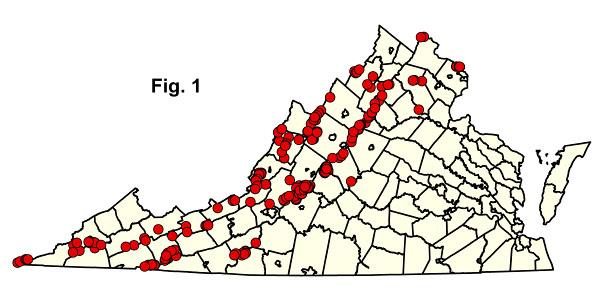
 保育與休閒部
保育與休閒部 保育。保護。享受。
 保育與休閒部
保育與休閒部  目錄
目錄山脈混合橡木和橡木-黑山森林
該群組含有相對多樣化的橡木和橡木果樹林,其中包括從地下到下山坡和山頂,主要位於約 600 米(2、000 英尺)和 1、200 m (4, 000 英尺) 海拔之間。
Montane mixed oak forests cover extensive areas in western Virginia and generally occupy intermediate positions along major environmental gradients such as soil moisture, soil fertility, and elevation. Soils occupied by montane mixed oak forests are typically less fertile than those of the true montane oak-hickory forests. Overstory composition contains mixtures of chestnut oak (Quercus montana), northern red oak (Quercus rubra), and white oak (Quercus alba). Overstory associates vary with geography and site conditions, but often include sweet birch (Betula lenta var. lenta), magnolias (Magnolia acuminata and Magnolia fraseri), sourwood (Oxydendrum arboreum), hickories (Carya spp.), red maple (Acer rubrum), tulip-tree (Liriodendron tulipifera), and white pine (Pinus strobus). The understories of mixed oak communities usually contain a substantial component of heaths, but also contain many non-ericaceous species such as witch hazel (Hamamelis virginiana var. virginiana), striped maple (Acer pensylvanicum), maple-leaved viburnum (Viburnum acerifolium), mountain holly (Ilex montana), buffalo-nut (Pyrularia pubera), and hazelnuts (Corylus cornuta var. cornuta and Corylus americana). The herbaceous component is relatively diverse, but often patchy and composed of both acidophiles and species characteristic of moderately fertile soils, including New York fern (Parathelypteris noveboracensis), galax (Galax urceolata), Curtis' goldenrod (Solidago curtisii), white wood aster (Eurybia divaricata), indian cucumber-root (Medeola virginiana), squawroot (Conopholis americana), halberd-leaved yellow violet (Viola hastata), speckled wood lily (Clintonia umbellulata), devil's-bit (Chamaelirium luteum), mountain golden-alexanders (Zizia trifoliata), and American lily-of-the-valley (Convallaria pseudomajalis).

Montane oak-hickory forests reach maximal importance on base-rich igneous, metamorphic, and subcalcareous sedimentary rocks. Two types occur throughout western Virginia: a submesic to mesic, rich type with a notably lush herb layer, and a drier, more acidic type with a diverse, often graminoid-dominated herb layer. Northern red oak, white oak, red hickory (Carya ovalis), and shagbark hickory (Carya ovata) are typical co-dominant trees, although in most stands oaks attain greater importance in the overstory than do hickories (Carya spp.), which often reach maximal density and cover in the understory. The chestnut oak is important only in the drier type, while mesophytic trees such as basswood (Tilia americana var. americana and var. heterophylla), bitternut hickory (Carya cordiformis), and sugar maple (Acer saccharum) are frequent associates in the rich type. The shrub layer of these communities is often sparse, and herbaceous composition varies with geography and site conditions. A widespread compositional variant on moist sites features extensive, nearly monospecific colonies of interrupted fern (Osmunda claytoniana). Fertile sites often support a diverse herbaceous flora, including such nutrient-demanding forbs as purple giant hyssop (Agastache scrophulariifolia), white bergamot (Monarda clinopodia), cutleaf coneflower (Rudbeckia laciniata var. laciniata), pale-leaved sunflower (Helianthus strumosus), richweed (Collinsonia canadensis), yellow jewelweed (Impatiens pallida), common black cohosh (Actaea racemosa), starry campion (Silene stellata), stout goldenrod (Solidago squarrosa), hairy-jointed meadow parsnip (Thaspium barbinode), and Appalachian meadow-rue (Thalictrum coriaceum). The luxuriance of such herb layers rivals that of the Rich Cove and Slope Forests. The drier type of montane oak-hickory forest features patch-dominance by Pennsylvania sedge (Carex pensylvanica), Porter's reedgrass (Calamagrostis porteri), wavy hairgrass (Avenella flexuosa), and xerophytic forbs.
這群組的社區是過渡到較高的高處和較貧窮地區的北部紅橡樹林,以及其較低海拔極限的其他幾個橡樹和橡木山林。它們與基本橡木-胡桃樹林和酸性橡木果樹林區分為它們通常在高處 >600 m2 (,000 ft) 以及缺乏許多明顯的低海拔物種類的花卉組成(例如東部紅芽 [Cercis canadensis var. 卡納登西斯] 和 開花的松葉木 [佛羅里達州]) 。它們與橡樹/溪谷森林有多樣性的地下植物和草本植物而區別。許多山脈混合橡木和橡木胡桃樹木植物代表了以前被美洲栗子( Castanea dentata )主導或共同主導的植物,在 世紀初被引入的栗子(Cryphonectria parasitica)摧毀之前,該物種的成熟個體被引入的栗子(Cryphonectria20 parasitica)摧毀。人們認為,山核桃(Carya spp.)從海底清除了美國栗子(Carya spp.)獲得了很大的好處,而它們在當代橡木山林中繼續招募,可能反映了近幾十年的火災排除。
參考文獻:亞當斯和斯蒂芬森(1983),庫林和拉溫斯基(1999),弗萊明(2007),弗萊明和庫林(2001),弗萊明和穆爾黑德(2000),約翰遜和韋爾(1982),麥科米克和普拉特(1980),拉溫斯基等。(1994),拉溫斯基等。(1996),斯蒂芬森(1982 a),斯蒂芬森(1982 b),斯蒂芬森和亞當斯(1991)。 © DCR-DNH,加里 ·P· 弗萊明。
© DCR-DNH,加里 ·P· 弗萊明。
該組由來自西弗吉尼亞州大多數縣和幾個離岸皮埃蒙特地點的 244 繪圖樣本代表(圖。1)。六種社區類型的分類受到了對地圖數據的幾個大型區域分析的良好支持。但是,該組織的南阿帕拉契亞代表需要額外的庫存來確定他們的全部州內分佈。點擊下面的任何突出顯示的 CEGL 代碼以查看由 NatureReserve 瀏覽器提供的全球 USNVC 描述。
 下載下面列出的每種社群類型的組成摘要統計資料表。
下載下面列出的每種社群類型的組成摘要統計資料表。

